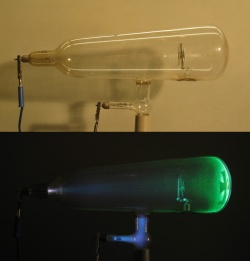Radiant Matter
Radiant Matter is the term that British physicist William Crookes used to describe what he believed was a fourth state of matter, in a time when the atom was thought to be a solid small ball, indivisible and without motion. Crookes's experimental work in this field was the foundation of discoveries which eventually changed the whole of chemistry and physics.
Crookes tubes
By the 1870s, the nature of electricity was a unknown and many experiments were done to determine what cathode rays were. William Crookes was able to generate a vacuum in tubes that possessed two metal electrodes, one at either end. These are known as "Crookes Tubes." When a high voltage is applied between the electrodes, cathode rays travel in straight lines from the cathode (negative) end to the anode (positive) end. Crookes found that as he pumped more air out of the tubes, the tubes became totally dark except for the anode end, where the glass of the tube itself began to glow. This gave rise to the name "radiant matter."
Crookes thought the cathode rays consisted of electrically charged atoms, but in 1897 Sir J. J. Thomson discovered they were not atoms, but a new particle, the first subatomic particle to be discovered, which was name "electron". Thus, Thomson proved that the cathode rays are streams of electrons.
Notes
Further reading
- On Radiant Matter by W. Crookes at Wikisource
